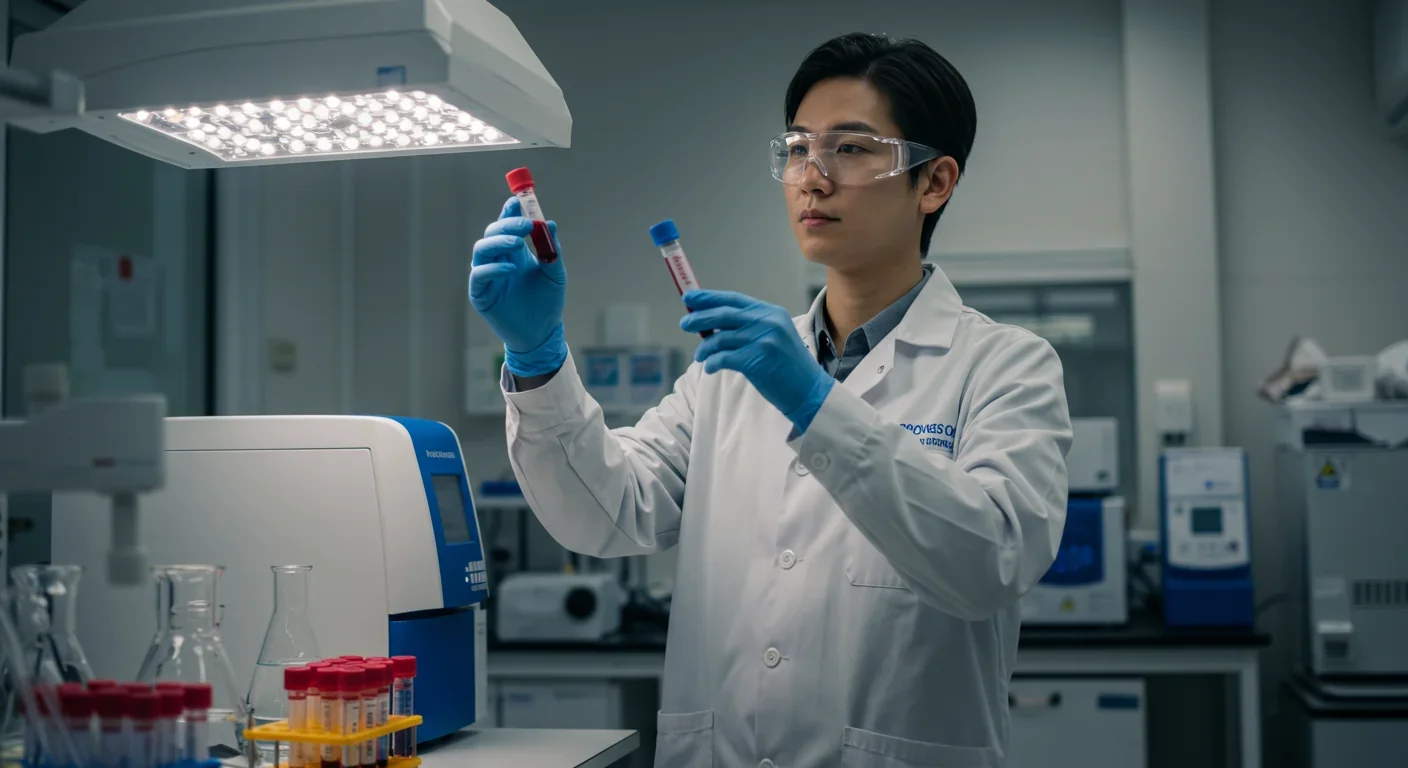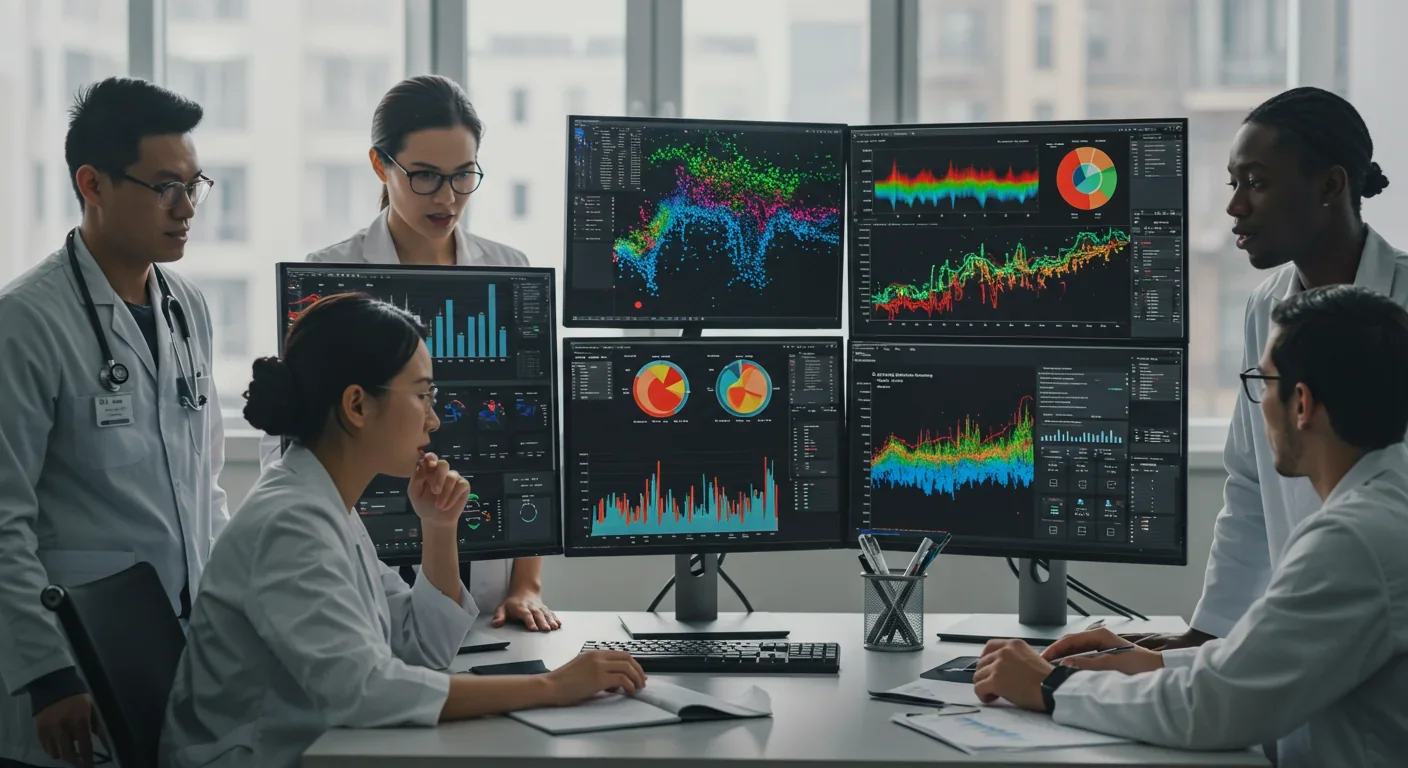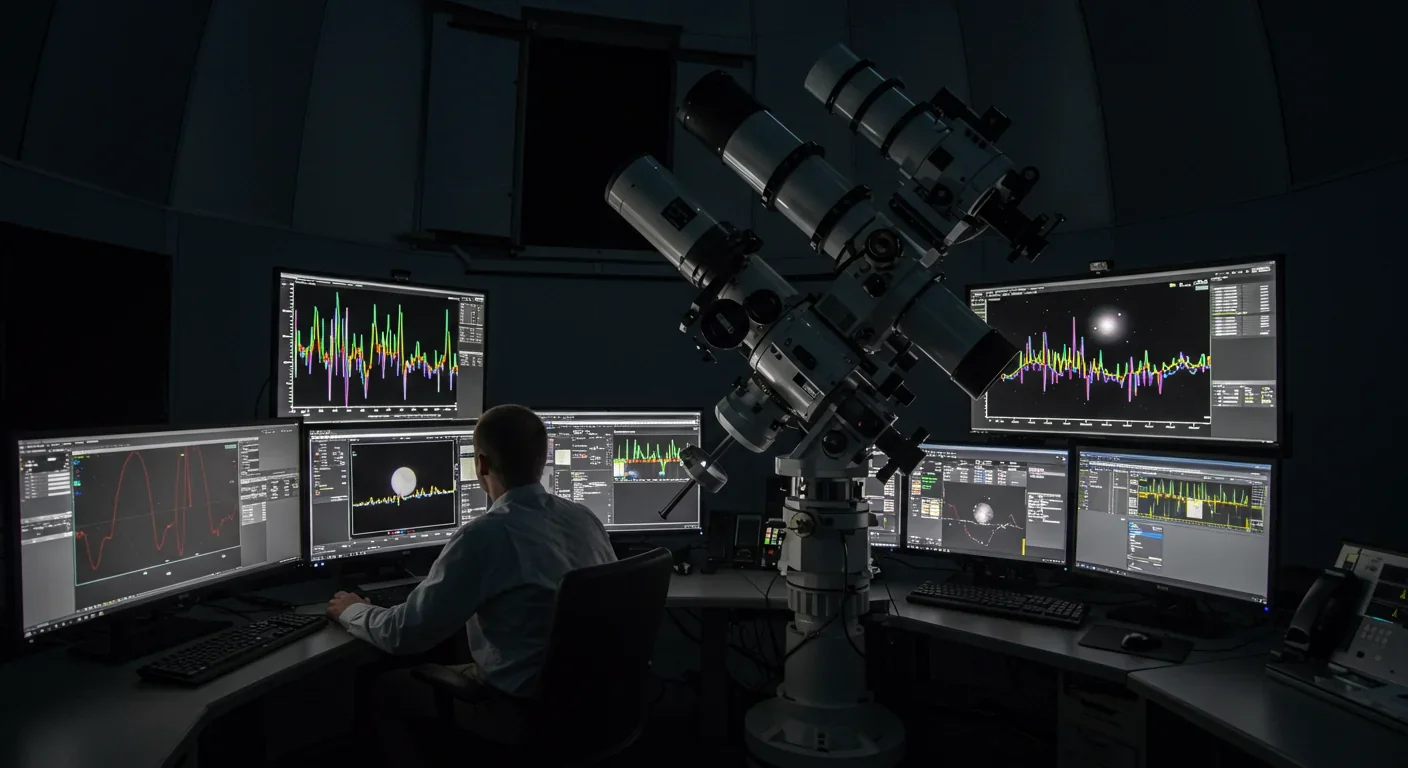Hidden Mold Mycotoxins Fueling Chronic Illness Epidemic

TL;DR: Scientists can now measure thousands of blood proteins to predict sixty-seven diseases—from diabetes to Alzheimer's to cancer—years before symptoms appear. This proteomics revolution promises to transform healthcare from reactive treatment to proactive prevention, but raises urgent questions about privacy, inequality, and the psychological burden of knowing your medical future. The technology exists today; whether it becomes medicine's greatest breakthrough or deepest ethical crisis depends on choices we make right now.

By 2030, your annual checkup might include a single blood test that predicts your risk for sixty-seven different diseases—from heart attacks to dementia to cancer—up to a decade before symptoms appear. This isn't speculative medicine. It's happening now in research labs across three continents, and the technology transforming disease prediction is called proteomics mapping.
While your DNA provides a blueprint written at birth, the twenty thousand proteins circulating in your bloodstream tell a different story: what's happening in your body right now. Scientists can now measure these proteins with unprecedented precision, identifying molecular signatures that forecast illness long before traditional tests detect anything wrong. The implications are staggering—imagine knowing you're on track for diabetes a full year before your glucose levels rise, or detecting Alzheimer's pathology while your memory remains sharp.
In July 2024, researchers analyzing forty thousand participants in the UK Biobank Pharma Proteomics Project published findings that sent ripples through the medical community: by profiling approximately three thousand blood proteins, they could predict the onset of sixty-seven distinct diseases with greater accuracy than conventional clinical tests. The list wasn't limited to common conditions like cardiovascular disease and diabetes—it included rare disorders such as multiple myeloma, motor neurone disease, idiopathic pulmonary fibrosis, and dilated cardiomyopathy.
What made this revelation particularly remarkable was the predictive timeline. For many conditions, altered protein signatures appeared years before diagnosis. The study demonstrated that protein-based models outperformed standard clinical measurements—blood cell counts, cholesterol panels, kidney function tests, and glycated hemoglobin readings—for most of the diseases examined.
"Measuring one protein for a specific reason, such as troponin to diagnose a heart attack, is standard clinical practice," explains Professor Claudia Langenberg, the study's lead author. "We are extremely excited about the opportunity to identify new markers for screening and diagnosis from the thousands of proteins circulating and now measurable in human blood."
The scale of measurable proteins has expanded exponentially. Current platforms can simultaneously quantify over eleven thousand proteins from a blood sample as small as fifty-five microliters—about ten drops. Across all proteomic technologies, researchers have identified 13,007 unique plasma proteins, representing a comprehensive molecular snapshot of human physiology.
The concept of blood biomarkers isn't new. For decades, clinicians have relied on individual protein measurements—C-reactive protein for inflammation, troponins for heart damage, prostate-specific antigen for cancer screening. But these approaches were like trying to understand a symphony by listening to a single instrument.
The Human Genome Project, completed in 2003, promised to revolutionize medicine by mapping our genetic code. Yet genes alone couldn't explain why some people with "high-risk" mutations never develop disease, while others with "low-risk" profiles do. The missing link was proteins—the molecular machines that actually do the work in our cells.
Just as the printing press democratized knowledge by making books accessible beyond monastery libraries, proteomics democratizes health information by making the body's functional state visible. Previous technological shifts followed similar patterns: telescopes revealed distant galaxies; microscopes exposed microbial worlds; MRI scanners visualized internal organs. Each breakthrough expanded our observational capacity. Proteomics does the same for molecular medicine.
The technology enabling this revolution emerged gradually. Mass spectrometry—originally developed for chemical analysis in the 1950s—was adapted for protein identification in the 1980s. By the 2010s, advances in sensitivity, throughput, and computational power transformed it into a clinical discovery tool. Parallel developments in antibody-based platforms, particularly proximity extension assays, allowed researchers to measure thousands of proteins simultaneously with remarkable precision.
Proteomics mapping relies on two primary technological approaches, each with distinct advantages.
Mass spectrometry-based proteomics fragments proteins into peptides, ionizes them, and measures their mass-to-charge ratios with extraordinary precision. Modern hybrid mass spectrometers—combining quadrupole, orbitrap, and time-of-flight analyzers—can identify and quantify thousands of proteins in a single run. The latest workflows process five hundred samples daily, identifying close to seven thousand proteins and quantifying seventy thousand molecular precursors per sample.
Platforms like Proteograph ONE have revolutionized sample preparation by using engineered nanoparticles to capture proteins across more than ten orders of magnitude in concentration—from the most abundant albumin to vanishingly rare signaling molecules. This automation enables population-scale studies that were previously impossible. A twenty-thousand-sample Korean study is currently using this technology to discover early-onset cancer biomarkers in young adults.

Affinity-based platforms use highly specific binding reagents to detect target proteins. SomaScan, for example, employs modified DNA aptamers called SOMAmers that fold into three-dimensional shapes complementary to specific proteins. When a SOMAmer finds its target, it generates a signal that can be quantified. The platform's eleven-thousand-protein assay covers half the genetically encoded human proteome with a median coefficient of variation of just 5.3 percent—two to three times more precise than competing technologies.
Olink's proximity extension assay pairs antibodies with DNA oligonucleotides. When two antibodies simultaneously bind the same protein target, their DNA tags join to form a double strand that can be amplified and quantified using next-generation sequencing. The Explore HT panel measures over 5,400 proteins from just two microliters of sample.
Both approaches transform a simple blood draw into a high-dimensional molecular portrait. The resulting data reveals which biological pathways are active, which organs may be stressed, and which disease processes might be beginning.
The integration of proteomics into medicine represents a fundamental shift from reactive to proactive healthcare. Currently, we diagnose disease after symptoms appear—chest pain triggers troponin measurement; memory loss prompts Alzheimer's testing. Proteomics flips this sequence.
Consider type 2 diabetes. Traditional screening detects elevated blood glucose, but by that point, beta-cell function has already declined significantly. Proteomic profiling identifies at-risk individuals much earlier. A 2025 study tracking 134 prediabetic individuals found that baseline levels of two proteins—dicarbonyl/L-xylulose reductase (DCXR) and glutathione S-transferase A3 (GSTA3)—were independently associated with 4.6-fold and 6.4-fold increased odds of developing diabetes within one year. Immune signaling proteins including IL-6, IL-1Ra, and ACP5 showed dysregulation a full year before diagnosis, highlighting inflammation as a potential early therapeutic target.
The cardiovascular field is experiencing similar transformation. A UK Biobank study of 51,859 adults measured 3,072 plasma proteins and followed participants for a median of 13.6 years. Among those who developed major adverse cardiovascular events, five proteins—NT-proBNP, proADM, GDF-15, WFDC2, and IGFBP4—showed the strongest predictive associations, with hazard ratios ranging from 1.68 to 1.41 per standard deviation increase. When researchers combined these protein measurements with conventional risk factors, the proteomic model improved risk prediction significantly, achieving better net reclassification and c-statistic performance than the standard PREVENT clinical risk score.
Cancer detection may see the most dramatic impact. A multimodal approach combining cell-free DNA fragmentomes with protein biomarkers detected ovarian cancer with 96 percent accuracy and greater than 99 percent specificity. Critically, the test identified 72 percent of stage I cancers—when treatment is most effective and survival rates are twelve times higher than at stage IV.
Industries across the healthcare ecosystem will adapt. Insurance models built on population averages will give way to individualized risk pricing. Pharmaceutical companies will use proteomic signatures to identify ideal candidates for clinical trials and to monitor drug efficacy in real-time. Employers offering workplace wellness programs will have objective molecular data to guide preventive interventions. Primary care will evolve from annual physicals focused on basic vitals to comprehensive molecular health assessments.
The job market will shift accordingly. Demand will surge for bioinformaticians capable of interpreting complex proteomic datasets, for genetic counselors who can communicate personalized risk profiles, and for healthcare navigators who help patients act on predictive information. Medical education will need to integrate proteomics literacy, teaching future physicians to think probabilistically about disease trajectories rather than diagnose established conditions.
Culturally, the availability of predictive health data will force societies to reckon with questions of identity and determinism. If you learn at age thirty-five that you have an 80 percent chance of developing Alzheimer's by seventy, how do you plan your career, your relationships, your retirement? When molecular data reveals vulnerability before symptoms arise, the boundary between "healthy" and "sick" dissolves into gradients of risk.
The benefits of proteomics extend far beyond earlier diagnosis. The technology enables truly personalized prevention.
A retrospective study of six hundred diabetic adults demonstrated this principle. Researchers combined proteomic biomarkers—soluble suppression of tumorigenicity 2 (sST2) and growth differentiation factor-15 (GDF-15)—with structural imaging data including coronary artery calcium scores and carotid plaque characteristics. The multimodal model achieved an area under the curve of 0.811 for predicting cardiovascular complications, significantly outperforming biomarker-only (AUC 0.774) or imaging-only models (AUC 0.735). More importantly, decision curve analysis showed that at a clinically relevant 20 percent risk threshold—commonly used for initiating preventive therapies like SGLT2 inhibitors—the combined model delivered a net benefit of 0.32, substantially higher than treating all patients or treating none.
This approach creates actionable treatment thresholds. Rather than applying one-size-fits-all guidelines—statins for everyone over fifty, aspirin for all diabetics—physicians can stratify patients by their actual molecular risk profile and reserve medications for those most likely to benefit.
Cost-effectiveness improves dramatically when screening becomes more specific. A two-step cancer detection strategy illustrates this principle. OncoSeek, a low-cost protein panel measuring seven tumor markers via electrochemiluminescence immunoassay, serves as a first-line screen. Individuals testing positive then undergo SeekInCare, a more expensive genomic assay. This sequential approach achieved 60 percent sensitivity at 98.3 percent specificity while reducing the false-positive rate from 9.0 percent to 0.7 percent. The per-individual screening cost dropped to $143, with a number needed to screen of 235 to detect one cancer—comparable to high-cost next-generation sequencing panels but at a fraction of the expense.
Neurodegenerative diseases represent another frontier where early detection could transform outcomes. Plasma phosphorylated tau-181 (ptau181) can differentiate healthy individuals from those with Alzheimer's pathology—and distinguish Alzheimer's from frontotemporal lobar degeneration—with 92 percent accuracy. This blood test matches the diagnostic performance of invasive cerebrospinal fluid sampling or expensive PET imaging. Critically, elevated plasma ptau181 levels among cognitively normal individuals predict later development of dementia, creating a window for preventive intervention before irreversible neuronal loss occurs.
"The development of a blood test would enable us to rapidly screen a much larger and more diverse group of volunteers who wish to enroll in studies," notes Dr. Richard Hodes, director of NIH's National Institute on Aging. This accessibility could accelerate therapeutic development by identifying at-risk individuals years before symptoms, when disease-modifying treatments are most likely to work.
Every technological revolution carries shadows, and proteomics is no exception.
Privacy and data security emerge as immediate concerns. Your proteomic profile reveals intimate details about your health trajectory, potentially exposing predispositions to mental illness, substance abuse susceptibility, or terminal diseases. Unlike genetic data, which remains relatively static, proteomic profiles change continuously, requiring repeated sampling and creating an expanding digital health footprint. Who owns this data? Can employers access it? Might insurers use molecular risk scores to deny coverage or inflate premiums? Without robust regulatory frameworks, proteomic information could become a tool for discrimination rather than empowerment.
Economic inequality threatens to widen health disparities. Current commercial proteomic tests cost between $1,000 and $2,500 per panel and are offered by only a handful of specialty laboratories. As long as proteomics remains expensive and accessible primarily through research studies or concierge medicine practices, its benefits will accrue disproportionately to wealthy populations. The technology risks creating a two-tiered system: affluent individuals receiving molecular health optimization while underserved communities continue relying on reactive sick-care.
Psychological burden accompanies predictive knowledge. Learning you have elevated risk for incurable neurodegenerative disease or aggressive cancer can trigger anxiety, depression, and fatalistic thinking. Unlike actionable risks—where lifestyle changes or medications reduce danger—some proteomic findings offer knowledge without recourse. How do healthcare systems provide adequate counseling and mental health support when molecular screening scales to millions of people?
Clinical validity gaps persist despite promising research. Most proteomic biomarkers have been validated in relatively homogeneous research cohorts—predominantly European ancestry populations recruited from biobanks in high-income countries. Performance in diverse ethnic groups, across different age ranges, and in real-world clinical settings remains uncertain. Premature clinical deployment before thorough validation could lead to misclassification, inappropriate interventions, and eroded trust.
Regulatory ambiguity complicates clinical translation. Unlike simple diagnostic tests, proteomic platforms often incorporate machine learning algorithms to generate risk scores. The FDA's Software as a Medical Device framework provides some guidance, but standards for analytical validity, clinical validity, and clinical utility remain inconsistent across jurisdictions. OncoSeek and SeekInCare received CE-IVD approval in the European Union in 2022, but comparable clearances in other markets lag behind.
Overdiagnosis and overtreatment represent perhaps the most insidious risk. When screening becomes extraordinarily sensitive, it detects molecular abnormalities that might never progress to clinical disease. Not every proteomic signature of cancer becomes symptomatic cancer; not every Alzheimer's biomarker culminates in dementia. Aggressive treatment of these "maybe diseases" can cause harm—chemotherapy side effects, surgical complications, medication adverse events—for conditions that would have remained dormant. Establishing observation thresholds versus intervention thresholds will require longitudinal outcome data that doesn't yet exist.
Proteomics development reflects broader geopolitical dynamics, with different regions pursuing distinct strategies.
Europe has positioned itself as the regulatory leader. The European Union's In Vitro Diagnostic Regulation (IVDR), implemented in 2022, establishes stringent requirements for proteomic assays entering clinical use. The Human Protein Atlas—a Swedish-led consortium—has created the Disease Blood Atlas containing next-generation blood profiling data from fifty-nine diseases built from ten thousand patient samples. This open-access resource accelerates biomarker discovery globally while reinforcing Europe's role in setting data standards.
The United States dominates commercial development. American companies including SomaLogic, Olink (acquired by Thermo Fisher), and Seer lead in platform innovation and market share. The NIH has invested heavily in Alzheimer's biomarker development, recognizing that blood-based screening could transform clinical trial recruitment and accelerate therapeutic approvals. However, fragmented healthcare delivery and insurance complexity may slow population-scale implementation compared to nations with unified health systems.
China is pursuing proteomics with characteristic scale and speed. The country's vast population, centralized health data infrastructure, and government coordination enable massive cohort studies. While publications from Chinese researchers on proteomic biomarkers have increased exponentially, concerns about data transparency and international collaboration persist. The question is whether China will share discoveries openly or retain them for competitive advantage.
Japan and South Korea emphasize precision and technological refinement. Korean researchers are deploying Proteograph ONE to analyze twenty thousand plasma samples—fifteen thousand from cancer patients, five thousand healthy controls—to discover biomarkers for early-onset cancers affecting young adults. Japanese consortia focus on integrating proteomics with robotics and AI for fully automated clinical diagnostics.
Lower-income nations face stark resource constraints. While proteomics offers transformative potential for disease prevention, the technology requires expensive instrumentation, specialized training, and sophisticated bioinformatics infrastructure. International cooperation through initiatives like the Human Proteome Organization (HUPO) attempts to bridge these gaps, but meaningful global equity will require technology transfer, capacity building, and dramatically reduced costs.

Intellectual property battles loom as commercial stakes rise. Patent portfolios covering SOMAmer technology, proximity extension assays, and machine learning algorithms create legal minefields. The tension between open science—which accelerates discovery—and proprietary platforms—which incentivize investment—will shape how quickly proteomics reaches patients worldwide.
As proteomics integrates into healthcare, individuals and institutions should prepare strategically.
For patients and consumers, health literacy must expand beyond basic nutrition and exercise to include molecular self-knowledge. Learn to ask physicians about proteomic screening options, understand what different biomarkers represent, and demand evidence-based interpretation rather than fear-mongering. Cultivate comfort with probabilistic thinking—a 30 percent risk isn't a death sentence, and an 80 percent risk isn't certainty. Advocate for data privacy protections in legislative forums and with healthcare providers.
For healthcare professionals, continuing education in proteomics interpretation becomes essential. Physicians trained in the era of binary diagnoses—you either have the disease or you don't—must learn to counsel patients navigating risk gradients. This requires statistical fluency, empathetic communication about uncertainty, and integration of molecular data with clinical judgment. Institutions should invest in decision support tools that translate complex proteomic signatures into clear action plans.
For policymakers, the imperative is establishing governance frameworks before rather than after crises emerge. Data protection regulations must address the unique characteristics of proteomic information—its dynamism, its predictive power, its intimate connection to identity. Reimbursement policies should incentivize validated preventive applications while discouraging unproven screening. International harmonization of regulatory standards will facilitate global research collaboration and equitable access.
For researchers and developers, the focus should shift from demonstrating feasibility—which is now established—to demonstrating utility. We need randomized controlled trials showing that proteomic screening actually improves clinical outcomes, not just that it predicts risk. Cost-effectiveness analyses must account for downstream consequences: prevented heart attacks, avoided chemotherapy, extended quality-adjusted life years. Diversity in study populations is non-negotiable; biomarkers validated exclusively in European cohorts may fail catastrophically in African, Asian, or Indigenous populations.
For entrepreneurs and investors, proteomics represents a multi-billion-dollar opportunity, but sustainable value creation requires patience. The multiplex assays market is projected to grow from $1.74 billion in 2024 to $6.75 billion by 2034, driven by efficiency gains and diagnostic accuracy improvements. Companies that prioritize rigorous validation, transparent communication, and equitable access will build lasting trust. Those chasing hype will face regulatory rejection and market backlash.
The skills most valuable in a proteomic future blend technical expertise with human judgment. Bioinformatics, computational biology, and machine learning capabilities will remain in high demand. But equally critical are skills machines cannot replicate: ethical reasoning about complex tradeoffs, compassionate communication of difficult information, and wisdom to distinguish helpful knowledge from harmful overreach.
The 2024 UK Biobank findings represent an inflection point. For the first time, we possess the technical capability to predict dozens of diseases from a single blood sample years before symptoms emerge. The question is no longer whether proteomics can transform medicine, but whether we will allow it to—and on what terms.
Three possible futures lie ahead.
In the optimistic scenario, proteomics catalyzes a genuine prevention revolution. Molecular screening becomes accessible and affordable globally. Regulatory frameworks protect privacy while enabling innovation. Healthcare systems reorient from treating sickness to maintaining wellness. Chronic diseases decline as risk factors are addressed proactively. Health disparities narrow as underserved populations gain access to predictive tools previously available only to elites. Life expectancy and quality of life both improve substantially.
In the pessimistic scenario, proteomics exacerbates existing inequalities and creates new harms. Wealthy individuals leverage molecular optimization to extend healthspan, while economic barriers exclude most of humanity. Insurance companies weaponize risk scores to deny coverage. Employers discriminate based on proteomic profiles. Overdiagnosis leads to cascades of unnecessary treatment. Privacy breaches expose intimate health data. Public trust collapses, and promising technology withers.
In the muddled-middle scenario—perhaps most likely—proteomics delivers uneven benefits. Some applications (cancer screening, cardiovascular risk stratification) prove clearly valuable and achieve broad adoption. Others (neurodegenerative prediction without effective treatments) generate controversy and remain niche. Access follows wealth gradients but slowly improves. Regulations lag behind technology but eventually catch up. The transformation happens, but messily, over decades rather than years, with both successes and failures shaping the path forward.
Which future we build depends on choices being made now in laboratories, boardrooms, regulatory agencies, and legislative chambers. It depends on whether patients demand access to their molecular data or fear it. It depends on whether profit motives align with public health or diverge destructively.
The proteins circulating in your blood right now are already telling your future story. The only question is whether you—and society—will listen, and what you'll do with that knowledge. The next decade will determine if proteomics mapping becomes the single greatest advance in preventive medicine or another technology that promises transformation but delivers disappointment. Place your bets wisely, because the stakes are measured in millions of lives, trillions of dollars, and fundamental questions about what it means to be healthy, to be sick, and to be human in an age when the future is written in molecules.

Over 80% of nearby white dwarfs show chemical fingerprints of destroyed planets in their atmospheres—cosmic crime scenes where astronomers perform planetary autopsies using spectroscopy. JWST recently discovered 12 debris disks with unprecedented diversity, from glassy silica dust to hidden planetary graveyards invisible to previous surveys. These stellar remnants offer the only direct measurement of exoplanet interiors, revealing Earth-like rocky worlds, Mercury-like metal-rich cores, and ev...

Hidden mold in homes releases invisible mycotoxins—toxic chemicals that persist long after mold removal, triggering chronic fatigue, brain fog, immune dysfunction, and neurological damage. Up to 50% of buildings harbor mold, yet most mycotoxin exposure goes undetected. Cutting-edge airborne testing, professional remediation, and medical detox protocols can reveal and reverse this silent epidemic, empowering individuals to reclaim their health.

Data centers consumed 415 terawatt-hours of electricity in 2024 and will nearly double that by 2030, driven by AI's insatiable energy appetite. Despite tech giants' renewable pledges, actual emissions are up to 662% higher than reported due to accounting loopholes. A digital pollution tax—similar to Europe's carbon border tariff—could finally force the industry to invest in efficiency technologies like liquid cooling, waste heat recovery, and time-matched renewable power, transforming volunta...

Transactive memory is the invisible system that makes couples, teams, and families smarter together than apart. Psychologist Daniel Wegner discovered in 1985 that our brains delegate knowledge to trusted partners, creating shared memory networks that reduce cognitive load by up to 40%. But these systems are fragile—breaking down when members leave, technology overwhelms, or communication fails. As AI and remote work reshape collaboration, understanding how to intentionally build and maintain ...

Mass coral spawning synchronization is one of nature's most precisely timed events, but climate change threatens to disrupt it. Scientists are responding with selective breeding, controlled laboratory spawning, and automated monitoring to preserve reef ecosystems.

Your smartphone isn't just a tool—it's part of your mind. The extended mind thesis argues that cognition extends beyond your skull into devices, AI assistants, and wearables that store, process, and predict your thoughts. While 79% of Americans now depend on digital devices for memory, this isn't amnesia—it's cognitive evolution. The challenge is designing tools that enhance thinking without hijacking attention or eroding autonomy. From brain-computer interfaces to AI tutors, the future of co...

The 2017 "Attention Is All You Need" paper introduced transformer architecture, revolutionizing AI by replacing sequential processing with parallel attention mechanisms. Transformers now power ChatGPT, DALL-E, and virtually every major AI breakthrough, achieving superior performance while training faster than previous models. This shift created new career opportunities, raised concerns about bias and environmental impact, and fundamentally changed how machines—and humans—interact with informa...